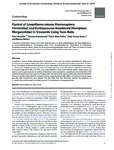Por favor, use este identificador para citar o enlazar este ítem:
http://www.alice.cnptia.embrapa.br/alice/handle/doc/1060358Registro completo de metadatos
| Campo DC | Valor | Lengua/Idioma |
|---|---|---|
| dc.contributor.author | NONDILLO, A. | pt_BR |
| dc.contributor.author | ANDZEIEWSKI, S. | pt_BR |
| dc.contributor.author | FIALHO, F. B. | pt_BR |
| dc.contributor.author | BUENO, O. C. | pt_BR |
| dc.contributor.author | BOTTON, M. | pt_BR |
| dc.date.accessioned | 2017-01-10T11:11:11Z | pt_BR |
| dc.date.available | 2017-01-10T11:11:11Z | pt_BR |
| dc.date.created | 2017-01-10 | pt_BR |
| dc.date.issued | 2016 | pt_BR |
| dc.identifier.citation | Journal of Economic Entomology, v. 109, n. 4, p. 1660-1666, 2016. | pt_BR |
| dc.identifier.uri | http://www.alice.cnptia.embrapa.br/alice/handle/doc/1060358 | pt_BR |
| dc.description | Linepithema micans (Forel) (Hymenoptera: Formicidae) is the main ant species responsible for dispersal of Eurhizococcus brasiliensis (Wille) (Hemiptera: Margarodidae), a root scale that damages grapevines in southern Brazil. The effects of different formulations of toxic baits based on boric acid and hydramethylnon to control L. micans and E. brasiliensis were evaluated. Toxic baits with boric acid (1.0%) mixed in different concentrations of inverted sugar (20%, 30%, and 40%), and hydramethylnon, mixed with sardines (paste), cassava flour and peanut, brown sugar (sucrose), or sardine oil-based gel, were evaluated in a greenhouse and in the field. In the greenhouse experiment, the number of foraging ants was significantly reduced in the pots where the hydrame- thylnon in sardine paste (Solid S), sardine oil-brown sugar-based gel (GEL SAM), and peanut oil-brown-sugar gel (GEL AM) formulations were applied. The GEL SAM toxic bait effectively reduced the infestation of L. micans , and could be used for indirect control of E. brasiliensis on young grapevines. Keywords : hydramethylnon, ant, scale, control | pt_BR |
| dc.language.iso | eng | eng |
| dc.rights | openAccess | eng |
| dc.subject | Videira | pt_BR |
| dc.subject | Ant | pt_BR |
| dc.subject | Control | pt_BR |
| dc.subject | Scale | pt_BR |
| dc.title | Control of linepithema micans (hymenoptera: formicidae) and eurhizococcus brasiliensis (hemiptera: margarodidae) in vineyards using toxic baits. | pt_BR |
| dc.type | Artigo de periódico | pt_BR |
| dc.date.updated | 2019-05-06T11:11:11Z | pt_BR |
| dc.subject.thesagro | Formiga | pt_BR |
| dc.subject.nalthesaurus | Hydramethylnon | pt_BR |
| riaa.ainfo.id | 1060358 | pt_BR |
| riaa.ainfo.lastupdate | 2019-05-06 -03:00:00 | pt_BR |
| dc.identifier.doi | 10.1093/jee/tow127 | pt_BR |
| dc.contributor.institution | ALINE NONDILLO, Laboratorio de Entomologia, Embrapa Uva e Vinho, Bento Gonc ?alves, RS, Brazil (alinondillo@gmail.com; SIMONE ANDZEIEWSKI, Departamento de Fitossanidade, Universidade Federal de Pelotas, Pelotas, RS, Brazil (simoneandzeiewski@yahoo.com.br); FLAVIO BELLO FIALHO, CNPUV; ODAIR CORREA BUENO, Centro de Estudos de Insetos Sociais, Instituto de Bioci ^ encias, Universidade Estadual Paulista, Rio Claro, SP, Brazil (odaircb@rc.unesp.br); MARCOS BOTTON, CNPUV. | pt_BR |
| Aparece en las colecciones: | Artigo em periódico indexado (CNPUV)  | |
Ficheros en este ítem:
| Fichero | Descripción | Tamaño | Formato | |
|---|---|---|---|---|
| nondillo2016.pdf | 573,5 kB | Adobe PDF |  Visualizar/Abrir |









